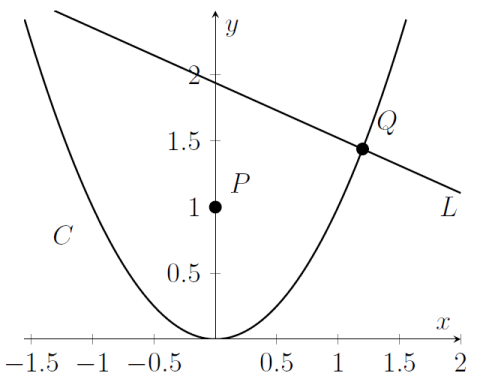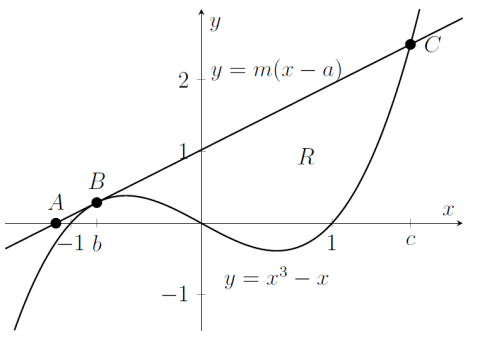Algebra
Part of the Oxford MAT Livestream.
MAT syllabus
Simple simultaneous equations in one or two variables. Solution of simple inequalities. Binomial Theorem with positive whole exponent. Combinations and binomial probabilities.
Revision
- Given two linear equations for $x$ and $y$ like $2x+3y=7$ and $3x+5y=9$, solve by rearranging the first for $x$ and substituting that into the second equation, then rearranging the resulting equation for $y$, before back-substituting for $x$.
- We can add and subtract from each side of an inequality.
- We can multiply each side of an inequality by a number, but if we multiply by a negative number then the direction of the inequality changes. For example, $-6<-3$, but when we multiply both sides by $-\frac{1}{3}$ we need to flip the sign to get the true statement $2>1$.
- Squaring each side of an inequality is like multiplying, and we need to be careful about cases where that's positive or negative. For example, $-2<-1$, but squaring each side would be like multiplying both sides by a negative number (so the direction of the inequality would change). Worse, $-1<3$, and squaring would be like multiplying the left by a negative number and the right by a positive number; that's not OK at all!
- (Binomial Theorem) If $n$ is a positive whole number then
$$(x+y)^n=x^n+nx^{n-1}y+\dots+\binom{n}{r} x^r y^{n-r}+\dots+nxy^{n-1}+y^n$$
where $\displaystyle \binom{n}{r} = \frac{n!}{r!(n-r)!}$ and $n!$ means $n\times (n-1)\times (n-2)\times\dots \times 2 \times 1$ for a whole number $n$. - (Combinations) Given $n$ different items, there are $\displaystyle \binom{n}{r}$ ways to choose $r$ of them.
- Proof of the above; suppose we list the $n$ items and take the first $r$ items on the list. There are $n!$ ways to list the items, but we've over-counted the ways to choose $r$ items because it doesn't matter what order the first $r$ are in, and it doesn't matter what order the other $(n-r)$ items are in. The way to fix all this over-counting is to divide; each real set of $r$ items appears in the above plan $r!(n-r)!$ times; the first factorial allows for all the separate orders of the $r$ items, and the other allows for all the orders of the $(n-r)$ items. So final answer is $\displaystyle \frac{n!}{r!(n-r)!}$.
- If the order of the items chosen matters (e.g. if we're counting the number of ways to choose who wins a prize, then who comes second, and so on) then we should only allow for over-counting from the irrelevant orderings of the $(n-r)$ other items, giving the final answer $\displaystyle\frac{n!}{(n-r)!}$.
- (Binomial probabilities) If $n$ independent events each have probability $p$ of success and probability $q$ of failure, with $p+q=1$, then the probability of exactly $r$ successes is $\displaystyle\binom{n}{r} p^rq^{n-r}$ for $0\leq r \leq n$.
Revision Questions
- Solve the simultaneous equations $x+4y=1$ and $2x-y=3$.
- Solve the simultaneous equations $x^2+2x+xy+y^2=5$ and $x+y=2$.
- Solve the simultaneous equations $x^2+y=2$ and $x+y^2=2$.
- Expand $(2x+3y)^3$
- What is the coefficient of the $x^2$ term in the polynomial $w(x) = (3x - 1)^4$?
- What is the sum of the coefficients of the polynomial $(x + 2)^{3}$? What about $(x+2)^{300}$?
- For which values of $x$ is it true that $x^2+4x+3>0$?
- Given $-2<a<1$, what can you say about $a^2$?
- Given $a<b$ and $c<d$, what (if anything) can you say about the relationship between $ac$ and $bd$? What (if anything) can you say if you're also told that $a>0$ and $c>0$?
- I'm going to flip five fair coins (each is heads or tails with equal probability, and each is independent of the others). What's the probability that I get exactly three heads?
- I've got six cards that have the numbers one to six on them. I'm going to shuffle them and then deal them out from left to right. What's the probability that the cards alternate between odd and even numbers (either starting with an odd number or an even number, then switching between odd and even for each subsequent card)?
- A game show has 10 contestants, and three finalists are chosen at random. What is the probability that contestant 1 is a finalist and contestant 2 is not?
- A class has 20 students, 10 boys and 10 girls. If the teacher randomly selects 4 students to answer a question, what is the probability that exactly three of them are girls?
- A multiple-choice test has 10 questions, each with 5 answer choices. If you guess on every question, what is the probability of getting at least 8 questions correct?
MAT Questions
MAT 2009 Q4
As shown in the diagram below: $C$ is the parabola with equation $y=x^2$; $P$ is the point $(0,1)$; $Q$ is the point $(a,a^2)$ on $C$; $L$ is the normal to $C$ which passes through $Q$.

(i) Find the equation of $L$
(ii) For what values of $a$ does $L$ pass through $P$?
(iii) Determine $|QP|^2$ as a function of $a$, where $|QP|$ denotes the distance from $P$ to $Q$.
(iv) Find the values of $a$ for which $|QP|$ is smallest.
(v) Find a point $R$ in the $xy$-plane but not on $C$, such that $|RQ|$ is smallest for a unique value of $a$. Briefly justify your answer.
Hints
(i) We need the gradient of $L$ and one point that lies on it. It clearly goes through $Q$, which has coordinates $(a,a^2)$. Remember that the normal is at right-angles to the tangent, and two lines are at right-angles if their gradients multiply to $-1$.
(ii) We've got an equation for $L$ now; let's assert that it goes through $P$ by plugging in $(0,1)$ and see what that gets us. This will be a necessary condition on $a$ for the line to go through the point; technically we should also check that it's sufficient by checking our answer and making sure that the line really does go through the point in all the cases that we identify.
(iii) This seems unrelated to the line $L$,but we've got two points and we know their coordinates. Let's use Pythagoras to write down the distance between them.
(iv) Reading the next part of the question, it seems that we'll get more than one solution for $a$ (because finding a special point $R$ such that the value is unique is the task in the next part). Before doing any calculations, can you see why there might be two values of $a$ (that is, two possible positions for $Q$), both of which minimise $|QP|$?
When it comes to the calculation to minimise the distance, it's sometimes easier to minimise $f(x)$ rather than $\sqrt{f(x)}$. Those two expressions have their local minima at the same values of $x$ as each other; can you see why?
(v) Remember your intuition in the previous part for the number of values of $a$ that minimise the distance. Could we have a similar situation where there's only one solution?
If we put $R$ at a general point $(r,s)$ it's going to be really messy to write down the distance $|RQ|$. Perhaps we could start by putting $R$ somewhere on the $y$-axis, like $P$ was.
We can approach this algebraically or geometrically.
Algebra advice: point at the bit of your work where it mattered that the $y$-coordinate was 1. What would change if we modified that number? Could the algebra give a different final answer?
Geometry advice: draw several sketches and draw a circle around a test point $R$. Imagine expanding the radius of the circle until it intersects the curve. Is there a unique "nearest" point?
Extension
[Just for fun, not part of the MAT question]
- What's the relationship between parts (ii) and (iv)? What's going on here?
MAT 2011 Q3 (modified)
The graphs of $y=x^{3}-x$ and $y=m\left( x-a\right) $ are drawn on the axes below. Here $m>0$ and $a\leqslant -1.$
The line $y=m\left( x-a\right) $ meets the $x$-axis at $A=\left(a,0\right) $, touches the cubic $y=x^{3}-x$ at $B$ and intersects again with the cubic at $C$. The $x$-coordinates of $B$ and $C$ are respectively $b$ and $c$. You are given that $a<-1$ and $a<b<0$.

(i) Use the fact that the line and cubic touch when $x=b,$ to show that $m=3b^{2}-1.$
(ii) Show further that
\begin{equation*}
a=\frac{2b^{3}}{3b^{2}-1}.
\end{equation*}
(iii) If $a=-10^{6}$, what is the approximate value of $b$?
(iv) Using the fact that
\begin{equation*}
x^{3}-x-m\left( x-a\right) =\left( x-b\right) ^{2}\left( x-c\right)
\end{equation*}
(which you need not prove), show that $c=-2b.$
(iv) $R$ is the finite region bounded above by the line $y=m\left(
x-a\right) $ and bounded below by the cubic $y=x^{3}-x$. For what value of $%
a $ is the area of $R$ largest?
Show that the largest possible area of $R$ is $\frac{27}{4}.$
Hints
(i) When a line touches a curve, it's got the same value and the same gradient. We know everything about the cubic, and we'd like to find the gradient and $y$-intercept of the line.
(ii) This part continues the idea that we're deducing facts about the line from the behaviour at $x=b$.
(iii) Let's use the previous part. It might be a good idea to investigate what the graph of $\displaystyle y=\frac{2x^3}{3x^2-1}$ looks like, roughly. Are there any points where the magnitude of $y$ gets really large?
(iv) We've got polynomials on both sides; let's multiply out and compare coefficients, and see what happens.
(v) We should probably do some integration to find that area. You may use the fact that if $f(x)>g(x)$ for $A<x<B$ and $f(A)=g(A)$ and $f(B)=g(B)$ then the area between the curves is $\int_A^B (f(x)-g(x))\,\mathrm{d}x$. We're given an expression for $f-g$ in the previous part of the question.
There's a choice to make here; do we substitute for values of $m$ and $a$, $b$, $c$ in terms of each other first, or do we integrate first and then substitute? My choice would be to replace $c$ with $-2b$ because that's nice and simple, and I would try to get everything in terms of $b$ before integrating.
Extension
[Just for fun, not part of the MAT question]
- Using what you know at the start of part (iv), prove that $$x^3-x-m(x-a)=(x-b)^2(x-c).$$
- Suppose instead that the cubic is $y=x^3-kx$, with $a<\sqrt{k}$ and $a<b<0$. Find the largest possible area of $R$ in terms of $k$.

